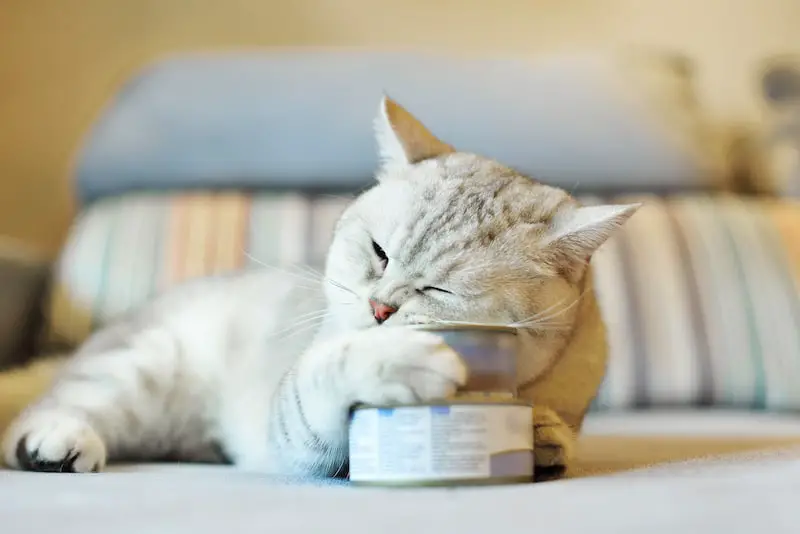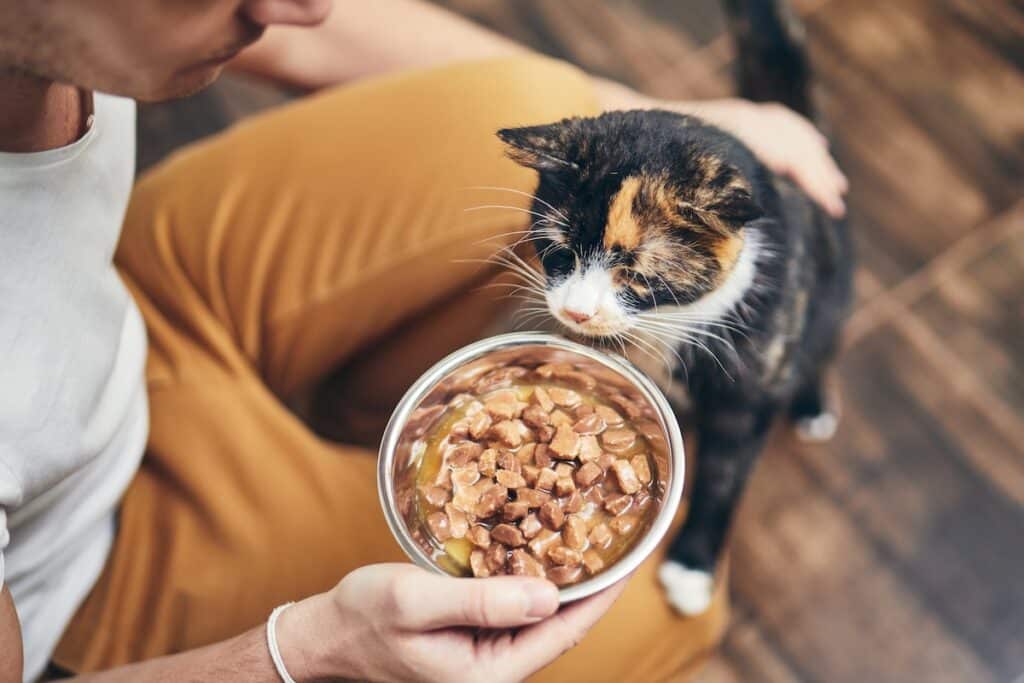On average, a should be eating one 6oz can of cat food per day, or two 3oz cans. Realistically, how much wet food you should feed a cat every day really depends on their weight, lean mass, age and metabolism. Also, different brands and flavors of cat wet food will affect how much you feed your cat. Keep in mind the amount of wet food served should be reduced if you’re also feeding dry food.
Wet Cat Food Feeding Chart
We’ve provided a feeding chart to to help give you general recommendations on how much wet food to feed a cat daily. However, these are just approximations and can vary based on the type of wet food and your cat’s metabolism.
| 5lb | 10lb | 15lb | 20lb | |
| Kitten | 7.7oz | 13oz | 17.8oz | 21.8oz |
| Lean Cat | 4.1oz | 6.7oz | 8.6oz | 10.6oz |
| Overweight Cat | 4.3oz | 5.8oz | 6.7oz | 7.4oz |
| Pregnant Cat | 5.8oz | 9.4oz | 12.2oz | 14.6oz |
Factors Affecting How Much Wet Food to Feed a Cat Every Day
As mentioned before, weight, lean mass, age and metabolism are all factors that will affect how much wet food you feed your cat. Other factors are brand and flavor of wet food and whether you’re also feeding dry food.
1. Weight & Lean Mass
Put together, weight and lean mass strongly determine how much wet food you’ll feed a cat every day. Heavier cats have more bone, muscle and tissue, which requires more energy. Lean mass comes into play, here, because it also burns more calories. It’s not just the weight that’s important, but the proportion of weight to lean mass that determines how much wet food a cat needs. For example, a 15lb cat with more lean mass vs. body fat will need more food than a 15lb cat with more body fat vs. lean mass.
Another thing to note here is if your cat is overweight (i.e. has a lot of body fat) you may want to put them on a diet. Obesity in cats causes a lot of problems such as diabetes and early death. Helping you cat lose weight will help them live a long and happy life.
2. Age
Kittens have the highest energy needs per pound of all cat ages because they’re growing and developing. Additionally, kittens use more energy by running around and playing more than older cats. Senior cats have the lowest energy requirements because their metabolism is slower.
3. Pregnancy
Pregnant or nursing cats need more food because they’re using a lot of energy developing and feeding kittens. They also have higher nutritional requirements to make sure the kittens are healthy. Kittens that are malnourished in the womb or while milk feeding can develop health issues.
There are a lot of additional considerations when feeding pregnant cats, so make sure you consult a vet on a special diet here.
4. Metabolism
The amount of wet food a cat needs every day will vary based on their metabolism. Cats with higher metabolisms use more energy and need more food. A cat’s metabolism can be determined by their genes or how active they are. Cats that are constantly engaged playing with you or other cats or toys will burn more calories and need more food than sedentary cats.
One of the main reasons cats are less active is because of boredom. Make sure you cat has plenty of toys and take time out of your day to play with them. Exercise is an excellent way to help your cat live a long and healthy life.
5. Cat Food Brands and Flavors
The calorie content of a can of wet food will vary by brand and flavor. For instance, a 3oz can of Fancy Feast Whitefish and Tuna Pate contains 85 calories, while a 3oz can of Friskies Chicken and Tuna Pate contains 97 calories. That’s almost a 10% difference in calories! Most cat food brands will list the calorie content in their cans on their website.
6. Whether You’re Also Feeding Dry Food
What matters here is the overall calories you’re feeding your cat each day. If you’re feeding your cat dry food you’ll need to reduce the amount of wet cat food you feed your cat each day.
Should I Feed My Cat Wet Food?
Wet food is considered to be healthier than dry food. Typically dry cat food contains more calories per pound and has more unhealthy additives. In addition, wet cat food provides water and is a main way cats stay hydrated. This is good for the kidneys and preventing health issues such as Feline Lower Urinary Tract Infections (FLUTD) or Feline Idiopathic Cystitis.
It’s a good idea to feed your cat wet food as it’s healthier overall.

Should I Feed My Cat Both Wet and Dry Food?
Some owners choose to feed their cat a combination of wet and dry food. Experts believe this is generally safe as your cat’s diet is still well-rounded.
Dry food is more affordable and easier to feed if you don’t have as much time. Many owners will feed their cat wet cat food once per day and supplement the rest of the calories with a bowl of dry food.
Monitoring Feeding
While the recommendations here are a great start on how much wet food to feed a cat each day, you might need to adjust based on observations. As mentioned previously, there are a lot of factors that affect how much food a cat needs. Each cat will respond differently to the same amount of food.
Make sure you weigh your cat weekly to monitor weight can, maintenance or loss. If your cat is losing weight, bump up their wet food amount. If they’re gaining weight, remove some food. The exception here is if your cat is under- or over-weight.
Read More: How to Help your Cat Lose Weight














